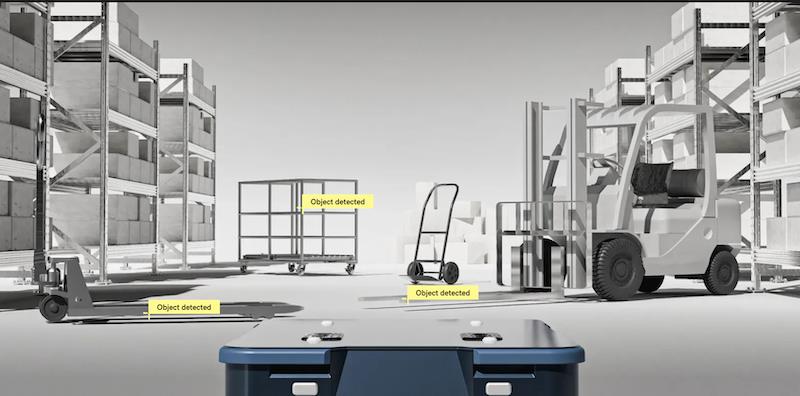
Sonair Raises $6.8 Million To Develop 'Breakthrough' 3D Ultrasonic Sensor Robotics & Automation News
Sonair has closed a new funding round, led by Skyfall Ventures, to“propel the robotics industry into a new era of sensing technology”.
The investment introduces a completely new category of sensors that will transform a mobile robot's spatial awareness from 2D to 3D, offering a significantly improved safety performance over traditional vision systems while cutting costs by 50-80 percent.
The company's Early Access Program now counts AMR manufacturers, automakers, and distributors from across the world.
The autonomous mobile robot (AMR) industry is growing rapidly at a 27 percent year-over-year rate. As these robots become more pervasive, the race to ensure they can safely navigate around people and obstacles is on.
Norwegian company Sonair is at the forefront of this innovation, launching what it describes as“a groundbreaking sensor that – for the first time – uses ultrasound in the air to give robots safe spatial awareness in 3D”.
One of the priciest components of an autonomous mobile robot (AMR) today is its sensor package, crucial for obstacle detection and safe navigation.
Current LiDAR systems are not only bulky and power-hungry but also computationally demanding, driving up costs and accounting for nearly a third of the robot's price.
A typical 2D LiDAR scanner in an AMR only sees a person's legs in one horizontal plane.
In contrast, Sonair's patented ADAR (Acoustic Ranging and Detection) technology detects people and objects in 3D, with low energy and computational requirements.
Knut Sandven, CEO of Sonair, says:“ADAR is an enabling technology for the entire mobile robot sector.
“For mobile robot builders, ADAR provides massive technology cost savings that can be passed on to end-users, boosting automation adoption worldwide.”
Sonair has now raised a total of $6.8M with Skyfall Ventures leading the latest $1.6 million round. RunwayFBU, another early-stage VC fund, also contributed to the round.
Preben Songe-Møller, partner at Skyfall Ventures, says:“We are incredibly excited to invest in the Sonair team, whose extensive experience in sensor technology, robotics, software, and AI, combined with their strong company-building expertise, is positioning Sonair as a truly exciting company.
“With reduced costs in sensor technology and AI advancements in perception and decision-making, industries from manufacturing to healthcare are poised to benefit from unprecedented efficiency and safety improvements.
“Sonair is uniquely positioned to help drive this transformation.”
Sagar Chandna at RunwayFBU, says:“In 2024 alone, up to 200,000 AMRs will be produced, it's a $1.4 billion market.
“Industrial automation and autonomy will be key drivers of this growth, but the cost of sensors remains a friction point. Sonair's innovations aim to resolve this challenge, unlocking even greater potential for the AMR industry.”
Ultrasonic sensors are less affected by environmental factors such as poor lighting, dust, or changing temperatures, ensuring reliable performance in diverse conditions where traditional sensors may fail.
Sonair's sensor can also detect reflective or see-through surfaces such as glass or mirrors without difficulty.
Benefits recently recognized at the international Sensors Converge event in Santa Clara, California in June this year, where Sonair won the Best of Sensors Award 2024 in the Automotive & Autonomous sensor category.
Evaluation kit delivers early tractionSonair is leveraging the new funding round to introduce its global early access program with an evaluation kit that has quickly been adopted by a wide range of warehouse AMR manufacturers, automotive OEMs, health- and cleaning robotics companies.
Sandven says:“Early access partners will get a first mover advantage on a breakthrough sensing technology that addresses society's urgent need for safe human-robot interaction in a cluttered world.”
Two decades in the makingThe patented ADAR technology has been in development at the world-renowned MiNaLab sensor and nanotechnology research center in Norway for more than 20 years.
The imaging method is called beamforming; it's the backbone of processing for sonar and radar, as well as in ultrasound imaging known in medicine but now used in the air.
By combining wavelength-matched transducers with cutting-edge software for beamforming and object-recognition algorithms, Sonair makes 3D spatial information available simply by transmitting sound and listening.
This allows mobile robots to detect distance and direction to all objects in a 180×180 field of view with a range of up to 5 meters, providing a wider field of view than existing technologies, while also detecting obstacles above and below the 2D plane of the LiDAR.
Manufacturers who choose Sonair also drastically reduce overall complexity by replacing several sensors that today attempt to compensate for the current limitations.
“Our technology is where AI, machine learning and automation truly converge,” says Sandven, who is also looking at markets for service robots, delivery robots, and robotic arms.
“We imagine a future where humans and robots coexist seamlessly, guided by ultra-compact 3D ultrasonic sensors.”
Legal Disclaimer:
MENAFN provides the
information “as is” without warranty of any kind. We do not accept
any responsibility or liability for the accuracy, content, images,
videos, licenses, completeness, legality, or reliability of the information
contained in this article. If you have any complaints or copyright
issues related to this article, kindly contact the provider above.


















Comments
No comment